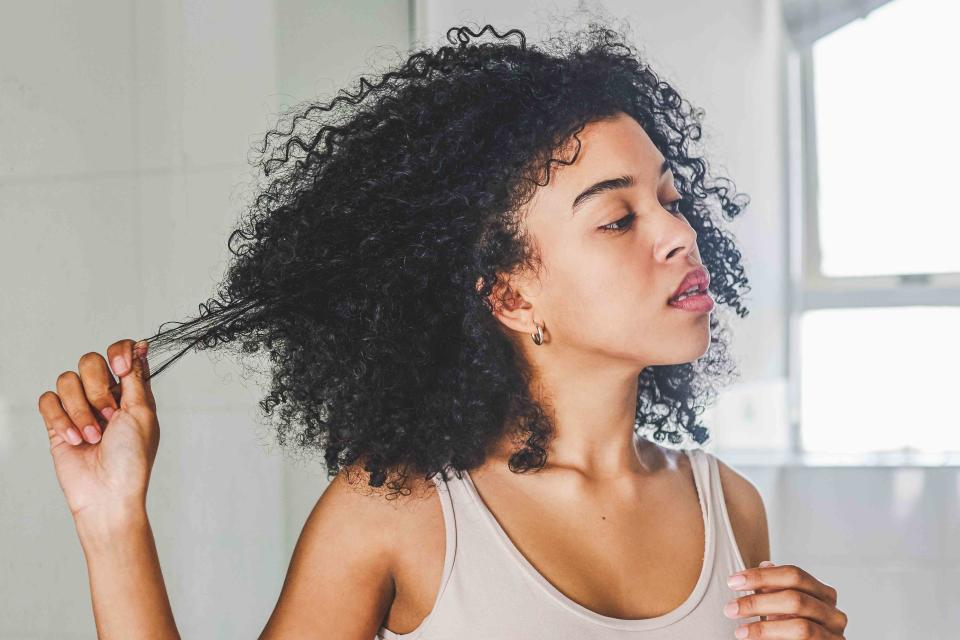Is Your Hair Frizzy or Dry? Here's How to Tell the Difference
The experts break it all down.

Getty Images
Frizzy hair often gets written off as dry hair. But in reality, there's a slight distinction, and therefore you'll require specific treatments and products based on your specific hair concerns. But how can you tell if you're dealing with frizzy hair vs. dry hair?
Well, there are subtle differences between the two (more on that later), but before getting into all that, we have to define a few things: What is dry hair? What is frizzy hair? And what products cater to both? We turned to the experts to get the scoop on it all. See what they had to say below.
What is dry hair?
Dry hair is when hair lacks moisture. According to Andrew Fitzsimons, celebrity hairstylist and founder of Andrew Fitzsimons Haircare, dry hair can happen for many reasons. Excessive hair washing, harsh soaps, or shampoos with drying ingredients (like parabens, sulfates, and alcohol), frequent heat styling, chemical treatments, climate, and even your diet can all contribute to your hair's hydration levels.
How do you treat dry hair?
The best way to treat dry hair is to find products that work well with your hair porosity and type. For those with natural curls or naturally low porosity hair (porosity just means how much moisture your hair can retain), trichologist Bridgette Hill says to look for products that contain humectants, such as glycerin and panthenol. These ingredients will help allow bonds in the hair to retain more moisture and soften your hair texture. For people with high porosity, fatty acids — like shea butter or cream-based humectants — are ideal to help fill and seal hair's fiber to lock in moisture.
When thinking about products for your hair type, Hill explains that those with straight hair should look for water-based leave-in products that contain small amounts of lipids for lightweight hydration that won't weigh down strands. Wavy hair, on the other hand, benefits from cream-based leave-in conditioners that have fatty acids and ingredients that will coat the fiber and enhance the shape of your waves. Finally, curly hair responds well to emollients and rich humectants that can properly coat the hair and define your curls.
For something a bit more universal, Fitzsimons recommends his AF1 Restructuring 10-in-1 Leave-In Conditioner, as it is made with nourishing ingredients such as ceramides, castor, and coconut oil to add moisture while also strengthening strands. "This will protect against further damage and split ends, keeping hair looking and feeling healthier and softer," he says.
Fitzsimons adds that some formulas for dry hair can work on most hair types. You just may need to use the products differently for fine, thick, or curly hair. "If you have fine hair, you might find yourself only needing the mask once a week and the leave-in every two to three days," he says. "But if you have naturally curly hair, you may want to use leave-in in your everyday routine."
What is frizzy hair?
When the hair cuticle is lifted, moisture can pass through and cause the hair shaft to swell, resulting in frizz. It can result from genetics, which determines your hair texture and type. Friz can also result in hair that's chemically damaged or hair that lacks proper moisture, lipids, and proteins.
Fitzsimons explains that your environment, such as the humidity in the air or how you wash your hair, can also be a main cause of frizz.
How do you smooth out frizzy hair?
The first way to tame frizzy hair if you want a sleeker look is to use smoothing-out products. Fitzsimons recommends something with hyaluronic acid, such as the Andrew Fitzsimons Prism Shine Softening Creme, to help hair retain moisture and boost shine. When it comes to your hair-washing routines, Hill recommends developing a regimen that will address your specific needs based on scalp condition, hair type, and texture. This will ensure that you don't end up over-shampooing, which can reduce the chances of frizz. Fitzsimons adds that finishing your shower with cold water can help lock in moisture.
Other things you can do to lessen frizz include using satin and silk pillowcases when you sleep, which Hill says will help keep the cuticle flat and seal in hydration.
Frizzy Hair vs. Dry Hair: How Do You Tell the Difference?
Dry hair comes from a lack of moisture in your strands. Frizzy hair, on the other hand, is the result of dryness or a number of different things like genetics, damage, environment, and routine.
"The difference between hair being frizzy and hair being dry is that dry hair refers to your hair lacking moisture," Fitzsimons says. "Frizzy hair can exist if there is too much moisture (humidity) or lack thereof. Dry hair could result in frizz, but the two are not mutually exclusive."
If you want a tangible way to determine whether your hair is frizzy or just dry, he says you can take one strand of wet hair from your head and gently pull at the ends. If the hair stretches and does not return to its original length, he says it's most likely a sign your hair is dry. To check for frizzy hair, take a wide section of your hair between two fingers and pull at the ends. If the texture of your hair is consistently smooth all the way down, most likely, you're dealing with frizz.
For more InStyle news, make sure to sign up for our newsletter!
Read the original article on InStyle.

